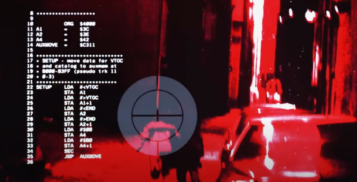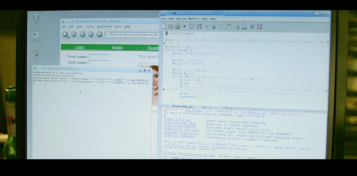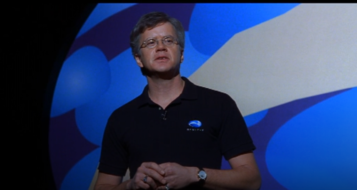For as long as I can remember I’ve always been both fascinated and horrified by the use of computers in movies. Who can forget the scene from Jurassic Park where the young hero sits at the terminal and says “It’s a Unix system, I know this”. We then get a view of the screen where she appears to be flying over 3D cubes which apparently represents files and programs. It was unlike any Unix system I’d ever used. This poor use of computers almost spoiled an otherwise very good movie.
A second example is The Terminator. When the cyborg assassin first arrived in 1984 from the year 2029 he was powered not by Skynet but by Assembly language from a 6502 chip from an Apple ][ (1977) as shown in the screenshot below. This was removed for later movies but for those that recognised the language, it could have spoilt the scene.
The last example is in Star Trek: The Voyage Home. Again, I enjoyed the movie but the ridiculous scene where Scotty and Bones travel back in time and try and explain to a manufacturer the formula for Transparent Aluminium lets the movie down badly. It’s not that Scotty tries to talk to the computer and then the mouse (as this is a viable mistake for somebody from the future) it’s the fact that he strikes a few keys on the Apple Mac keyboard and suddenly on the screen, he has the diagram for the formula for a product that doesn’t yet exist. Which magic keys did he press?
However there have been many films that do make good use of computers and although the awards season is over for another year, I would suggest that before they start creating the nominees for 2022 they create a new category for the Oscars, the Golden Globes and the BAFTAs called The Best use of Computers in a Movie. I think over time this would become the pre-eminent award, eventually surpassing Best Movie and leading Actor/Actress. As this award does not currently exist, I have created a shortlist of the top 5 movies of all time for which the winner will get a prestigious Golden Orb. To win this award the movie has to be both entertaining and make good use of computing either because it’s used realistically or because it’s used in a way that is convincing (especially in sci-fi movies).
Please note that beyond this point there are spoilers so if you haven’t yet watched these movies you may want to skip ahead.
Shall we play a game?
Let’s start with a movie that came out in 1983. WarGames is an American Cold War techno-thriller starring Matthew Broderick as David Lightman, a young hacker who unwittingly accesses a United States military supercomputer and believing he is playing an unreleased computer game, runs a nuclear war simulation (Global Thermonuclear War) on a computer called WOPR. This prompts not only a missile scare but nearly starts a nuclear war against the Soviet Union.
The movie was written by Lawrence Lasker and Walter F. Parkes who used several experts to give the film its realism. One of these was John “Captain Crunch” Draper who was an early hacker and reformed phone phreak. He explained in a Wired interview “The use of a dialler scanner program came from me repeatedly dialling up numbers until I found a computer modem. It’s called wardialing now because David Lightman used it in the movie to make contact with the Norad computer.”
The computer used by Broderick in the movie was also real. He had a 1975 microcomputer, based on the Intel 8080 called an IMSAI 8080 which was a clone of the more famous Altair 8800. The setup included an IMSAI IKB-1 intelligent keyboard, an IMSAI 212A modem and a IMSAI FDC-2 dual 8-inch floppy drive. The IMSAI machine ran a highly modified version of the CP/M operating system called IMDOS which is shown clearly in the movie.
Because of this realism and attention to detail WarGames became a cult classic for people who work in IT (and beyond). In 2008 Google hosted a 25th-anniversary screening, where the Silicon Valley audience cheered Broderick’s every move. “Many of us grew up with this movie,” Google cofounder Sergey Brin told the packed house. “It was a key movie of a generation, especially for those of us who got into computing.”
David Scott Lewis, the one-time hacker who was the model for Broderick’s David Lightman character, spoke about the movie at the 2008 Defcon conference and said “WarGames had the most accurate representation of real hacking than any other hacker movie. It didn’t have all this ridiculous 3-D virtual reality and other nonsense. In the real world, hackers used command prompts that had no visualization tools.” Take note Jurassic Park.
I have established that the use of computers is realistic but is the movie good? The answer for me is yes. When I was younger, I loved this film and wanted the same setup as Matthew Broderick had in his bedroom. There is something about monochrome CRT monitors that I still love even to this day. The action and story are good too, especially towards the end where the sense of urgency grows as the missiles are about to be launched. I’m not alone in my love for this film, on the review site Rotten Tomatoes it has a very high rating of 93%. It’s definitely a movie of its time but I love it and for this reason, it’s my first nomination.
Let the hacking begin
One evening in 2003, Harvard undergrad Mark Zuckerberg started programming his new idea for a Social Media site. What began as a dorm room idea quickly became a global social media phenomenon and within 6 years later Mark Zuckerberg had become the youngest billionaire in history. The movie The Social Network (2010) tells this story detailing both his personal and legal problems along the way.
Initially, I wasn’t that keen on watching this movie as I was afraid of another Hollywood character assassination, and I was more interested in the more positive, entrepreneurial aspects of how a start-up grew so quickly. The movie does have its less positive elements as the central story centres on 2 legal actions against Zuckerberg. Firstly, the Winklevoss twins, who had asked Zuckerberg to help with their Harvard dating application sued the company for theft of intellectual property. Secondly, Eduardo Saverin (Andrew Garfield) who had provided the initial funding for Facebook and was essentially the founding partner and friend of Zuckerberg threatened to sue when an angel investment diluted his share of Facebook from 34% to 0.03%. Eduardo Saverin acted as the main consultant for Ben Mezrich’s book The Accidental Billionaires on which the movie is based and so he is portrayed in a more sympathetic light than he may otherwise have been. For instance, the shareholding was in fact diluted from 24% to about 10% and not the values shown in the movie. In fact, Eduardo Saverin made several billion dollars for his initial $30k investment. However, as these 2 disputes are central to the initial story, they needed to be included. I think how you feel about the portrayal of Mark Zuckerberg depends on what you thought of him to start with, but personally, I didn’t find his portrayal unsympathetic, instead, he came across to me as a socially awkward genius, bored by the simplicity of his Harvard course and driven to create something great. Isn’t that the case with most super successful IT entrepreneurs?
Importantly for the purposes of this blog, the movie contains one of the most detailed uses of computers in any movie. Jesse Eisenberg (as Mark Zuckerberg) narrates how he created the predecessor to Facebook (Facemash) by hacking directories of students from various Harvard colleges. This 8-minute section of the movie describes in detail how he gets the photos from each college’s directory. You see Perl and PHP scripts, MySQL queries and wget commands as well as listening to a commentary on how these tools are used to get the photos and names he needs. I watched this again recently and couldn’t help wondering what a non-IT person thinks of this section but for me it was great.
Ultimately the story managed to be dramatic, entertaining and at times quite funny. It also received nominations for 8 Academy Awards including Best Picture, Best Actor and Best Adapted Screenplay which it won. For this reason, it is nominated for the Golden Orb award.
Everything that has a beginning has an end
In 1977 in Metz, France an audience gathered expectantly to listen to the science fiction writer Philip K. Dick. Instead of talking about his books (many of which led to successful adaptations such as Bladerunner, Total recall, Minority Report, The Adjustment Bureau, and the recent TV series The Man in the High Castle), he instead laid out his belief that we are all living in a simulation. This clip from the trailer of the documentary A Glitch in the Matrix which explores this idea shows the start of his lecture.
Of course, to those of us that missed this talk at the time, this theory is nothing new and that’s because in 1999 the Wachowskis released the movie The Matrix. This film depicts a dystopian future in which humanity is unknowingly trapped inside a simulated reality, the Matrix, which machines have created to distract humans while using their bodies as batteries. When computer programmer and hacker Neo (Keanu Reeves) has the truth revealed to him by Morbius (Laurence Fishburne) he becomes part of a rebellion against the machines.
The Matrix (as Philip K. Dicks tried to tell us) is more than a story. In a passage from Plato’s Republic (ca 380 BCE), Plato asks us to imagine a scenario where a freed prisoner who has only known an existence where he is part of a group of prisoners who live their lives underground and shackled, discovers the truth about reality. If he was then returned to his cell, his fellow prisoners would have no means to understand what he has experienced and think him mad.
In The Matrix, Neo is freed by rebel leader Morpheus (the name of the Greek God of sleep) and he similarly finds himself in a world that is unbelievable and frightening.
We can’t judge the use of computers in this film as we have done with contemporary movies such as WarGames and the Social Network, but we can imagine (as Philip K. Dick did) that this computer world is a possibility (some would say a probability) and for that reason, it must be included on the list. Indeed, the main characters such as Agent Smith, the Oracle and the Merovingian are all programs within the Matrix and later in the trilogy, we discover the Keymaker who is a keygen program that can encrypt a proper token to access any locked device or any domain (via a “software backdoor”). At one point Agent Smith even hypothesises that humans are a virus within the matrix.
“The only way for you to survive is to spread to another area. There is another organism on this planet that follows the same pattern… a virus. Human beings are a disease, a cancer on this planet, you are a plague, and we… are the cure.”
Ironically it turns out the virus may have been Agent Smith himself but hopefully, the point is clear that the Matrix is a movie that makes us think as much about our own lives as we do about the Sci-Fi world it depicts. For this reason and the fact that it’s also a very entertaining film (going on to win 4 Oscars), it makes it onto the list.
It’s not about winning, it’s about playing.
The movie Ready Player One (2018) is set in another dystopian future. In 2045, most of the population spend their time in the OASIS, an immersive virtual universe. In the OASIS, you can go anywhere, do anything, and be anyone you want. The OASIS was created by James Halliday (Mark Rylance), who on his death left his fortune and total control of the OASIS to the winner of a cryptic three key contest he designed to find a worthy heir. When Wade Watts (Tye Sheridan) wins the first car racing challenge, he and his friends find themselves in another race against a corporation called Innovative Online Industries (IOI) who have their own ideas on how the OASIS should be run.
I like the fact that the virtual world is not shown as some hyper-realistic simulation as we saw in the Matrix but instead uses a computer game style for the world and the avatars. At one point we see Batman climbing a mountain, we see the Batmobile in the opening car race and Wade’s own car is the DeLorean from Back to the Future. The movie is packed with cultural references from King Kong through to War of the Worlds and Duran Duran (who get a few mentions).
Most importantly for consideration of the Golden Orb award, not only is the OASIS a computer program but the final challenge (spoiler) is based on the concept of the first-ever Easter Egg in a computer game. This was an attempt by programmer Warren Robinett to add his name into his Atari 2600 game called Adventure, without Atari’s consent. Adventure sold more than a million copies at $25 but paid developers like Warren Robinett $20,000 a year. Warren Robinett explained in an interview with Forbes, “Atari kept us, programmers, all anonymous. They weren’t going to give us any leverage or any name recognition with the consumers because we might start asking for things like royalties.“ He continued, “I was not clever enough to think of a way to get a piece of those profits, but I did think of a way to get public recognition, which was to hide my name in the game in the secret room in a place that’s really hard to get to. That’s what I did. I didn’t call it an Easter egg, but that name was bestowed on it by someone else.” This Easter Egg is at the core of the movie.
Overall, “Ready Player One” is a nostalgic journey through pop culture whilst still making a few pertinent points about how technology has affected humanity for both good and bad. It doesn’t judge that for many technology is their only escape from an otherwise monotonous life but it does still end up showing that real life can be better (at least on Tuesdays and Thursdays). For nerds, the movie is both enjoyable and, as with most Steven Spielberg films, visually stunning. For pure entertainment and for the successful use of pop culture in a way many other movies have failed (yes I’m looking at you Pixels) this film makes it onto my list.
You’re either a one or a zero. Alive or dead.
On May 18, 1998, the U.S. Justice Department and 20 state attorneys general filed an antitrust suit against the then most powerful tech company in the world: Microsoft. The issue was the rise of the Netscape browser which Microsoft feared would supplant the desktop operating system as the primary way people interfaced with computers. Microsoft soon began developing Internet Explorer, and at the same time started to work out how to reduce Netscape’s market share. This was one of the first cases that relied on emails as evidence some of which seemed to show that Microsoft at the time was doing things to protect their operating system, and not to benefit consumers. There were these phrases like “take away their oxygen supply” and “crush them.”
It was in this light that the movie Antitrust was written and appeared in theatres in 2001. The movie portrays a young idealistic programmer called Milo Hoffman (Ryan Phillippe) and a large corporation (NURV) run by a charismatic CEO of NURV Gary Winston (Tim Robbins). Initially, Milo is wowed by the attention of NURV and the personal attention of Gary Winston. He leaves his own start-up and his best friend Teddy Chin to work on NURV’s flagship product Synapse which is planned to be a ubiquitous satellite-based worldwide media distribution network. Hoffman becomes suspicious that whenever they are stuck on a particular issue Winston personally provides him with the answer through some new source code, while always refusing to divulge the code’s origin. When his old business partner and friend Teddy Chin is murdered, Milo becomes increasingly suspicious and tries to unravel the truth of NURV’s operation.
Although NURV is a generic Silicon Valley super corporation it’s quite clear what company gave the scriptwriters the inspiration. Gary Winston looks like Bill Gates, and he even gets a name check when he shows off his electronic artwork which changes based on who enters the room. Milo asks, “Doesn’t Bill Gates have something like that?” Winston replies, “Bill Gates? Who is that?”. In 2001 Computer World even ran an article saying that Gary Winston was based on Bill Gates. For the purposes of this blog, it doesn’t really matter but it does give the movie some context based on what people were thinking of large Tech companies at the time.
I watched it again recently and whilst technology has moved in there is nothing jarring for an IT audience and that is because to make the SYNAPSE project plausible the filmmakers had consulted with several experts in the computer and satellite communications fields, in particular with Tim Lindholm, a Distinguished Engineer at Sun Microsystems. “Tim was critical in helping advise us not only about what the future might hold but also in assuring technical accuracy of the script,” said the producer David Nicksay in an interview for cinema.com. “We want the movie to be enjoyed by an audience that doesn’t understand computers, but we also want to make sure that people who are very advanced engineers see that it’s a plausible premise.” They also used Gentry Lee, chief engineer for the Galileo spacecraft and director of Science Analysis and Mission Planning on NASA’s Viking project, to provide up-to-the-minute ideas on how a satellite-based wireless communications system like the one NURV is creating would be constructed. This attention to detail along with a fast-paced dot.com conspiracy thriller makes this another entry in my nominations.
And the winner is…
I had a long list of about 20 movies for this blog, but I tried to choose different types of films rather than have 5 very similar subjects. For instance, there are several hacker movies such as Hackers (unrealistic but fun), Swordfish (nice car), The Net (poor use of computers again), Black Hat (forgettable plot) and many biopics (especially of Steve Jobs) such as Jobs, the Pirates of Silicon Valley and Steve Jobs which was initially on the list, but I thought the Social Network is a better movie and concentrated more on the product rather than just the personality.
There are also several documentaries that are feature-length which I love but didn’t fit into the category such as Triumph of the Nerds, Indie Game and the Social Dilemma. Similarly, recently we have had many great IT-related TV series such as Silicon Valley, Mr Robot and Halt and Catch Fire. I may come back to those in a different blog later.
And so finally for me, there is only one winner and that is WarGames. It was one of the first movies of this type and still one of the best. There has been talk of a remake and there is already a horrible sequel called WarGames 2.0: The Dead Code but really the movie is perfect as a cold war piece that reflects the start of the computer revolution of the 1980s.
I’m sure most of you will disagree about both my list and the winner so feel free to comment and let me know your favourite remembering the criteria I set out at the beginning.
What do you think?
Views: 744